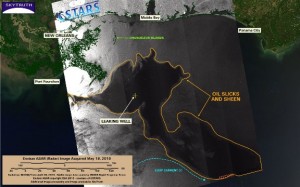Author’s note: Just trying to be objective in the article, but I think someone is lying their ass off about this one.
Excerpt:
After BP released underwater video footage of the oil gushing into the Gulf of Mexico, conflicting estimates of the amount of oil leaking raise many questions.
What is the rate of flow? How much oil is already in the water? Is there any way to make an accurate assessment? When will it hit shore? What will be the economic and environmental impact? Does anyone really know the answers, and if so, who is telling the truth?
The current reports on the rate of flow range from a minimal estimate of about 210,000 gallons per day to an extreme of 8.4 million gallons per day. That means that since April 20, anywhere between 5.04 million and 201.6 million have been released into the water. Keep in mind that it takes only one quart of oil to poison 250,000 gallons of seawater for all marine life.
It is becoming clear that no one knows exactly how much oil has leaked into the Gulf of Mexico, but a review of the conflicting reports and their sources can give one a general idea of the magnitude of this disaster.
An initial report by BP and the National Oceanic and Atmospheric Administration (NOAA) shortly after the well erupted on April 20 put the rate of flow at 1000 barrels per day, which at 42 gallons per barrel, is 42,000 gallons per day. A report by the same sources on April 28 upped that to the 5000 barrels per day that has been accepted without question by most media outlets, until recently.
According to the New York Times, “The figure of 5,000 barrels a day was hastily produced by government scientists in Seattle. It appears to have been calculated using a method that is specifically not recommended for major oil spills.” It was calculated with a protocol known as the Bonn convention that calls for measuring the extent of an oil spill, using its color to judge the thickness of oil atop the water, and then multiplying.
Several scientists not affiliated with BP or the federal government have used other methods and calculated that the rate of oil flow is far higher than 5000 barrels per day.
Dr. Ian R. MacDonald, an oceanographer at Florida State University, who is an expert in the analysis of oil slicks, made his own calculations using satellite imagery. They suggested that the leak could “easily be four or five times” the government estimate, he said. Other scientists agree that the leak is much larger than BP and the federal government have revealed.
Steve Wereley, an associate professor at Purdue University, told NPR the actual spill rate of the BP oil disaster is about 3 million gallons a day – 15 times the official guess of BP and the federal government. Wereley analyzed videotape of the seafloor gusher using a technique called particle image velocimetry, which is accurate to a degree of plus or minus 20 percent.
According to NPR, another scientific expert, Eugene Chiang, a professor of astrophysics at the University of California-Berkeley, calculated the rate of flow to be between 840,000 and four million gallons a day. Without even having a sense of scale from the BP video, he deduced that the diameter of the pipe was about 20 inches. And though his calculation is less precise than Wereley’s, it is in the same ballpark. “I would peg it at around 20,000 to 100,000 barrels per day,” he said. Chiang called the current estimate of 5,000 barrels a day “almost certainly incorrect.”
Timothy Crone, an associate research scientist at the Lamont-Doherty Earth Observatory, used another well-accepted method to calculate fluid flows. Crone arrived at a similar figure, but he said he’d like better video from BP before drawing a firm conclusion.
Paul Noel, a software engineer contractor working at the U.S. Army arsenal in Redstone, AL, who also has extensive experience in the oil and gas industry, puts the figure even higher – at 8.4 million gallons per day. Writing for Pure Energy Systems News, Noel bases his estimate on two additional factors, a process called Fractioning and his claim that the actual diameter of the source of the leak is five feet, not 21 inches as is commonly reported.
Rising through 5000 feet of water, the oil is going through a process…call[ed] Fractioning. Literally the tremendous pressure and temperature [cause]…the oil and Natural Gas [to] change on their way up. The very light, easy-to-evaporate parts are all that is rising to the surface. The heavy oil isn’t even getting to the top…the chemicals added at the well head to disburse the oil, speed this process up. Because of this fractioning, what you see from the air on the surface of the water represents maybe just 20% of the volume of the various types of oil in that area.
Furthermore:
The numbers on the Transocean rig are for the drill pipe size. The inside hole of the drill pipe is 18 inches and the outside is 21. The platform numbers are for a 60.5 inch drill platform opening. This is what fits the outer casing. It is used to torque the casing down into the well. The platform is used at the turntable to torque the well drill pipe. I have seen lots of these wells. They are really 5 feet in diameter.
So, at one extreme estimate, oil is erupting at a rate of 4 barrels per second through a five foot hole in the sea bed. At the other extreme, “only” about 5000 barrels per day are gushing through a 21 inch in diameter pipe. Most scientists put the number somewhere in between.
If Noel is correct that 80% of the oil is heavier than water and remains below the surface, then that explains why tar balls are washing up on the beaches of Louisiana, Alabama and Mississippi. If BP and the NOAA are correct, that still means the oil leak in on track to exceed the amount of oil that the Exxon Valdez spilled in 1989 by June 11. If the scientists with the mid-range estimates are correct, this already is the worst oil disaster in the history of the world.
Either estimate raises even more questions. The most pertinent to coastal residents of Louisiana, Alabama, Mississippi and Florida are: When will this oil slick hit the shores and what will the economic impact be? If no one knows how large this oil leak is, or if anyone does and are not revealing the truth, then it is impossible for Gulf residents to know what to prepare for.
Read more, get links and video here: http://www.examiner.com/x-38220-Orlando-Independent-Examiner~y2010m5d15-Widely-varying-estimates-about-severity-of-oil-leak-in-Gulf-raise-many-questions






Teabaggers Take Over!